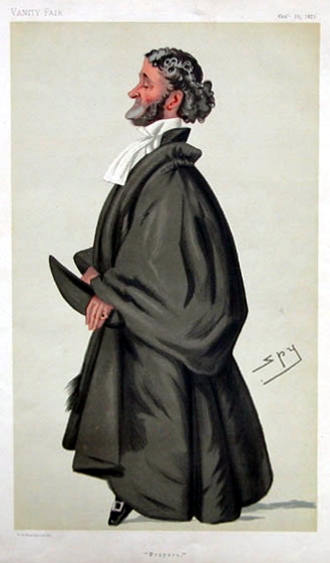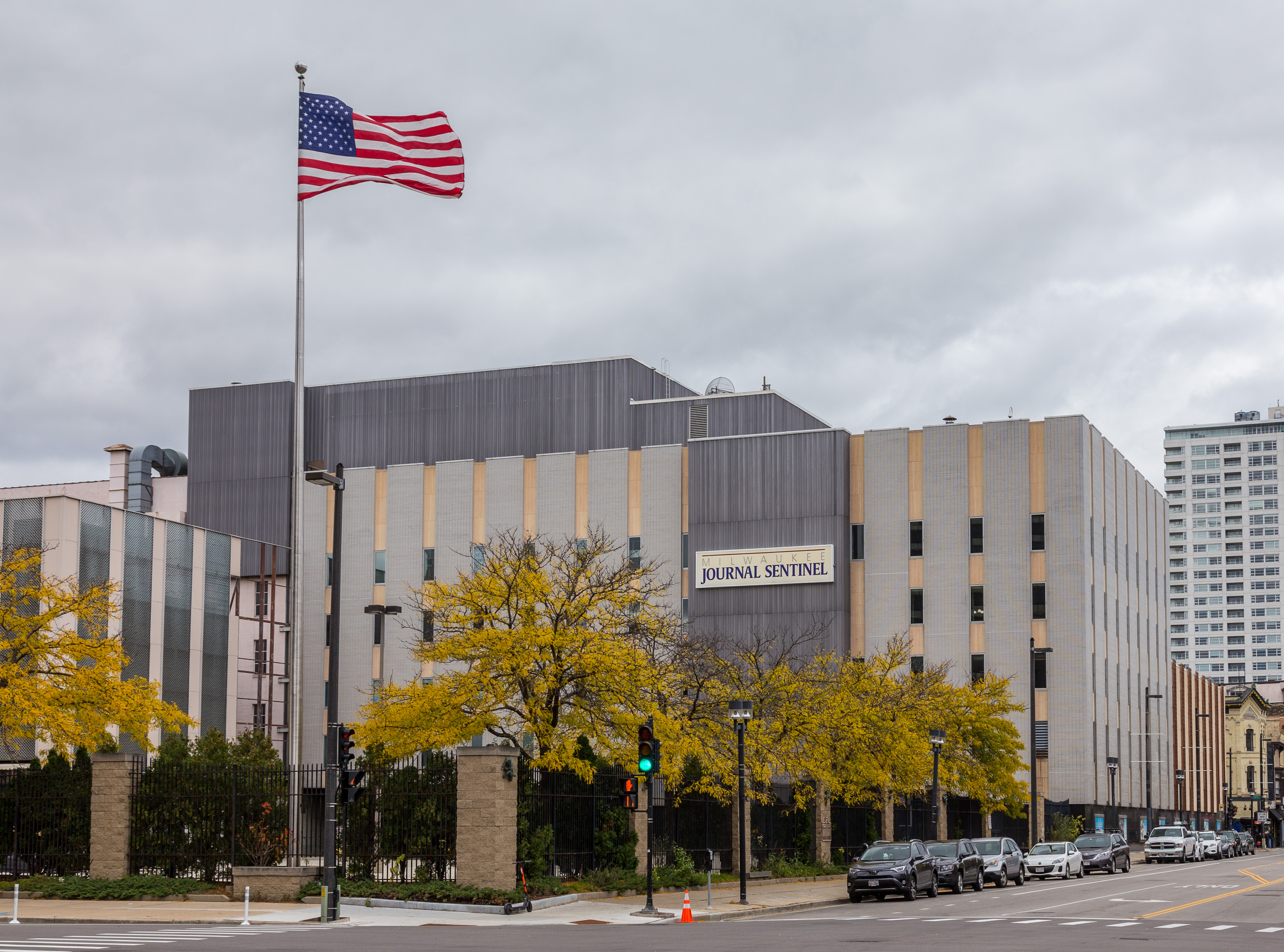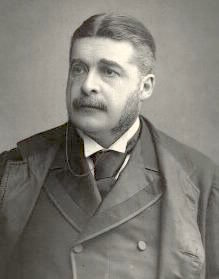|
Francis Edmund Cecil Byng, 5th Earl Of Strafford
Rev. Francis Edmund Cecil Byng, 5th Earl of Strafford (15 January 1835 – 18 January 1918) was an English Anglican minister and member of the peerage. Background Byng was born 15 January 1835, third son of George Byng, 2nd Earl of Strafford. He was educated at Eton (where he took a Prince Albert Prize for Modern Languages) and Christ Church, Oxford, where he studied law and modern history. Religious career After taking holy orders, Byng became the rector of Little Casterton, Rutland from 1859–62; served as vicar of Holy Trinity in Twickenham and chaplain at Hampton Court from 1862-67. He was appointed an honorary chaplain to Queen Victoria in 1867 and Chaplain-in-Ordinary in 1872; then served as Chaplain to the Speaker of the House of Commons from 1874-89. In 1867, Byng was appointed vicar of the high church St Peter's Church, Cranley Gardens, by Charles James Freake (who had the living of the church). He remained vicar of St Peter's, which became fashionable ("His ... [...More Info...] [...Related Items...] OR: [Wikipedia] [Google] [Baidu] |
Francis Edmund Byng Vanity Fair 18 October 1879
Francis may refer to: People *Pope Francis, the head of the Catholic Church and sovereign of the Vatican City State and Bishop of Rome *Francis (given name), including a list of people and fictional characters *Francis (surname) Places * Rural Municipality of Francis No. 127, Saskatchewan, Canada * Francis, Saskatchewan, Canada **Francis (electoral district) *Francis, Nebraska *Francis Township, Holt County, Nebraska * Francis, Oklahoma *Francis, Utah Other uses * ''Francis'' (film), the first of a series of comedies featuring Francis the Talking Mule, voiced by Chill Wills *''Francis'', a 1983 play by Julian Mitchell *FRANCIS, a bibliographic database * ''Francis'' (1793), a colonial schooner in Australia *Francis turbine, a type of water turbine *Francis (band), a Sweden-based folk band * Francis, a character played by YouTuber Boogie2988 See also *Saint Francis (other) *Francies, a surname, including a list of people with the name *Francisco (other) *Francis ... [...More Info...] [...Related Items...] OR: [Wikipedia] [Google] [Baidu] |
Hampton Court
Hampton Court Palace is a Grade I listed royal palace in the London Borough of Richmond upon Thames, southwest and upstream of central London on the River Thames. The building of the palace began in 1514 for Cardinal Thomas Wolsey, the chief minister of Henry VIII. In 1529, as Wolsey fell from favour, the cardinal gave the palace to the king to check his disgrace. The palace went on to become one of Henry's most favoured residences; soon after acquiring the property, he arranged for it to be enlarged so that it might more easily accommodate his sizeable retinue of courtiers. Along with St James' Palace, it is one of only two surviving palaces out of the many the king owned. The palace is currently in the possession of King Charles III and the Crown. In the following century, King William III's massive rebuilding and expansion work, which was intended to rival the Palace of Versailles, destroyed much of the Tudor palace.Dynes, p. 90. His work ceased in 1694, leaving the pala ... [...More Info...] [...Related Items...] OR: [Wikipedia] [Google] [Baidu] |
Milwaukee Journal
The ''Milwaukee Journal Sentinel'' is a daily morning broadsheet printed in Milwaukee, Wisconsin, where it is the primary newspaper. It is also the largest newspaper in the state of Wisconsin, where it is widely distributed. It is currently owned by the Gannett Company.Gannett Completes Acquisition of Journal Media Group . ''USA Today'', April 11, 2016. In early 2003, the ''Milwaukee Journal Sentinel'' began printing operations at a new printing facility in West Milwaukee. In September 2006, the ''Journal Sentinel'' announced it had "signed a five-year agreement to print the national edition of '' |
Benefices
A benefice () or living is a reward received in exchange for services rendered and as a retainer for future services. The Roman Empire used the Latin term as a benefit to an individual from the Empire for services rendered. Its use was adopted by the Western Church in the Carolingian Era as a benefit bestowed by the crown or church officials. A benefice specifically from a church is called a precaria (pl. ''precariae)'', such as a stipend, and one from a monarch or nobleman is usually called a fief. A benefice is distinct from an allod, in that an allod is property owned outright, not bestowed by a higher authority. Roman Catholic Church Roman imperial origins In ancient Rome a ''benefice'' was a gift of land (precaria) for life as a reward for services rendered, originally, to the state. The word comes from the Latin noun ''beneficium'', meaning "benefit". Carolingian Era In the 8th century, using their position as Mayor of the Palace, Charles Martel, Carloman I and Pepin II ... [...More Info...] [...Related Items...] OR: [Wikipedia] [Google] [Baidu] |
Freemasonry
Freemasonry or Masonry refers to fraternal organisations that trace their origins to the local guilds of stonemasons that, from the end of the 13th century, regulated the qualifications of stonemasons and their interaction with authorities and clients. Modern Freemasonry broadly consists of two main recognition groups: * Regular Freemasonry insists that a volume of scripture be open in a working lodge, that every member profess belief in a Supreme Being, that no women be admitted, and that the discussion of religion and politics be banned. * Continental Freemasonry consists of the jurisdictions that have removed some, or all, of these restrictions. The basic, local organisational unit of Freemasonry is the Lodge. These private Lodges are usually supervised at the regional level (usually coterminous with a state, province, or national border) by a Grand Lodge or Grand Orient. There is no international, worldwide Grand Lodge that supervises all of Freemasonry; each Grand Lod ... [...More Info...] [...Related Items...] OR: [Wikipedia] [Google] [Baidu] |
Arthur Sullivan
Sir Arthur Seymour Sullivan (13 May 1842 – 22 November 1900) was an English composer. He is best known for 14 comic opera, operatic Gilbert and Sullivan, collaborations with the dramatist W. S. Gilbert, including ''H.M.S. Pinafore'', ''The Pirates of Penzance'' and ''The Mikado''. His works include 24 operas, 11 major orchestral works, ten choral works and oratorios, two ballets, incidental music to several plays, and numerous church pieces, songs, and piano and chamber pieces. His hymns and songs include "Onward, Christian Soldiers" and "The Lost Chord". The son of a military bandmaster, Sullivan composed his first anthem at the age of eight and was later a soloist in the boys' choir of the Chapel Royal. In 1856, at 14, he was awarded the first Mendelssohn Scholarship by the Royal Academy of Music, which allowed him to study at the academy and then at the Felix Mendelssohn College of Music and Theatre, Leipzig Conservatoire in Germany. His graduation piece, inc ... [...More Info...] [...Related Items...] OR: [Wikipedia] [Google] [Baidu] |
Organist
An organist is a musician who plays any type of organ (music), organ. An organist may play organ repertoire, solo organ works, play with an musical ensemble, ensemble or orchestra, or accompany one or more singers or instrumentalist, instrumental soloists. In addition, an organist may accompany congregational hymn-singing and play liturgy, liturgical music. Classical and church organists The majority of organists, amateur and professional, are principally involved in church music, playing in churches and cathedrals. The pipe organ still plays a large part in the leading of traditional western Christian worship, with roles including the accompaniment of hymns, choral anthems and other parts of the worship. The degree to which the organ is involved varies depending on the church and denomination. It also may depend on the standard of the organist. In more provincial settings, organists may be more accurately described as pianists obliged to play the organ for worship services; nev ... [...More Info...] [...Related Items...] OR: [Wikipedia] [Google] [Baidu] |
Otago Witness
The ''Otago Witness'' was a prominent illustrated weekly newspaper in the early years of the European settlement of New Zealand, produced in Dunedin, the provincial capital of Otago. Published weekly it existed from 1851 to 1932. The introduction of the Otago Daily Times followed by other daily newspapers in its circulation area lead it to focus on serving a rural readership in the lower South Island where poor road access prevented newspapers being delivered daily. It also provided an outlet for local fiction writers. It is notable as the first newspaper to use illustrations and photographs and was the first New Zealand newspaper to provide a correspondence column for children, which was known as "Dot's Little Folk". Together with the Auckland based ''Weekly News'' and the Wellington based ''New Zealand Free Lance'' it was one of the most significant illustrated weekly New Zealand newspapers in the 19th and early 20th centuries. History Background Nine months after the first immi ... [...More Info...] [...Related Items...] OR: [Wikipedia] [Google] [Baidu] |
Benefice
A benefice () or living is a reward received in exchange for services rendered and as a retainer for future services. The Roman Empire used the Latin term as a benefit to an individual from the Empire for services rendered. Its use was adopted by the Western Church in the Carolingian, Carolingian Era as a benefit bestowed by the crown or church officials. A benefice specifically from a church is called a precaria (pl. ''precariae)'', such as a stipend, and one from a monarch or nobleman is usually called a fief. A benefice is distinct from an allodial title, allod, in that an allod is property owned outright, not bestowed by a higher authority. Roman Catholic Church Roman imperial origins In ancient Rome a ''benefice'' was a gift of land (precaria) for life as a reward for services rendered, originally, to the state. The word comes from the Latin language, Latin noun ''beneficium'', meaning "benefit". Carolingian Era In the 8th century, using their position as Mayor of the Pa ... [...More Info...] [...Related Items...] OR: [Wikipedia] [Google] [Baidu] |
Charles James Freake
Sir Charles James Freake, 1st Baronet (7 April 1814 – 6 October 1884) was an untrained English architect and builder, responsible for many famous 19th-century façades in London, including Eaton Square, Exhibition Road and Onslow Square, mainly specialising in domestic architecture for wealthy clients. From humble beginnings and apprenticeship as a carpenter, he became a master builder, patron of the arts — especially music — and a philanthropist. Career Freake's father, Charles Freake, was originally a coal merchant. In the 1820s, he took a lease of the Royal Oak public house in Elizabeth Street, Belgravia (a mainstay of the blossoming Grosvenor Estate), Westminster. Being a publican apparently became his main business but he speculated in building projects. In 1837, he granted his son (who was described as a carpenter) a sub-lease of a small mews house by the Royal Oak. In 1838, Charles James Freake (now described as a builder) acquired some house plots in Eliza ... [...More Info...] [...Related Items...] OR: [Wikipedia] [Google] [Baidu] |
Hammersmith
Hammersmith is a district of West London, England, southwest of Charing Cross. It is the administrative centre of the London Borough of Hammersmith and Fulham, and identified in the London Plan as one of 35 major centres in Greater London. It is bordered by Shepherd's Bush to the north, Kensington to the east, Chiswick to the west, and Fulham to the south, with which it forms part of the north bank of the River Thames. The area is one of west London's main commercial and employment centres, and has for some decades been a major centre of London's Polish community. It is a major transport hub for west London, with two London Underground stations and a bus station at Hammersmith Broadway. Toponymy Hammersmith may mean "(Place with) a hammer smithy or forge", although, in 1839, Thomas Faulkner proposed that the name derived from two 'Saxon' words: the initial ''Ham'' from ham and the remainder from hythe, alluding to Hammersmith's riverside location. In 1922, Gover pr ... [...More Info...] [...Related Items...] OR: [Wikipedia] [Google] [Baidu] |
High Church
The term ''high church'' refers to beliefs and practices of Christian ecclesiology, liturgy, and theology that emphasize formality and resistance to modernisation. Although used in connection with various Christian traditions, the term originated in and has been principally associated with the Anglican tradition, where it describes churches using a number of ritual practices associated in the popular mind with Roman Catholicism and Eastern Orthodoxy. The opposite tradition is '' low church''. Contemporary media discussing Anglican churches erroneously prefer the terms evangelical to ''low church'' and Anglo-Catholic to ''high church'', even though their meanings do not exactly correspond. Other contemporary denominations that contain high church wings include some Lutheran, Presbyterian, and Methodist churches. Variations Because of its history, the term ''high church'' also refers to aspects of Anglicanism quite distinct from the Oxford Movement or Anglo-Catholicism. There rema ... [...More Info...] [...Related Items...] OR: [Wikipedia] [Google] [Baidu] |





.jpg)


